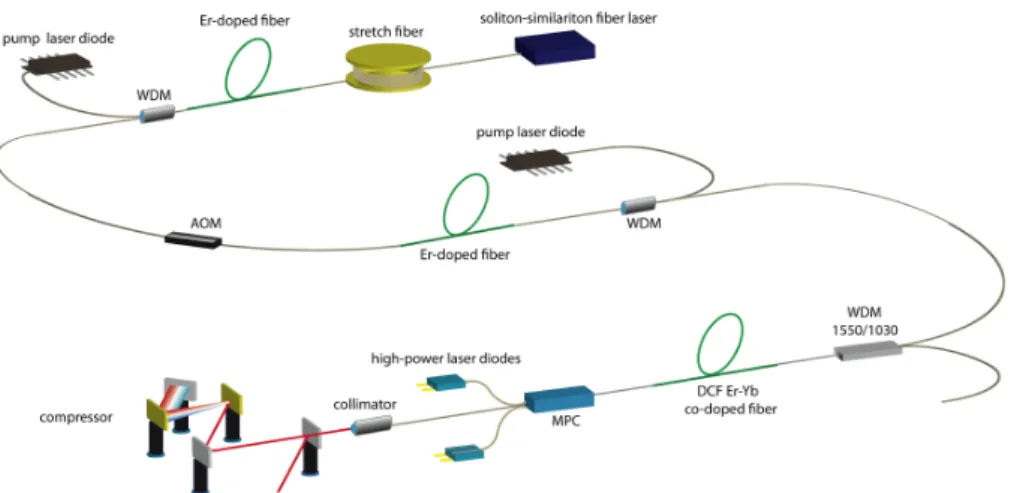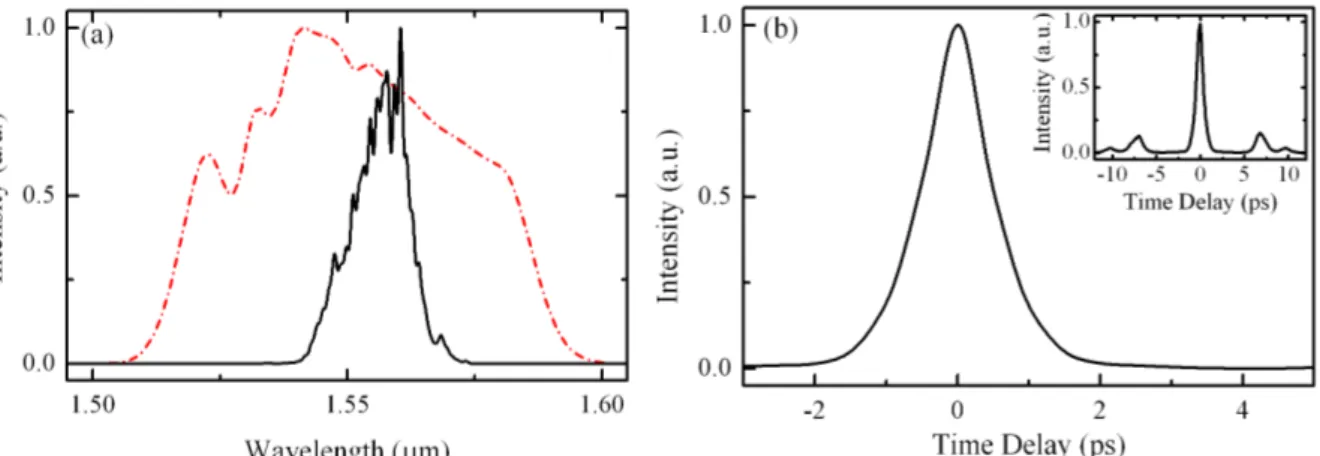CTu2M.2.pdf CLEO Technical Digest © OSA 2012
Nonlinear chirped-pulse amplification of a
soliton-similariton laser to ~1 µJ at 1550 nm
E. Ilbey1, I. Pavlov1,3, E. Dülgergil2, B. Öktem1, S. Yavas1, A. Rybak1,3, Z. Zhang1, F. Ömer Ilday1 1Department of Physics, Bilkent University, TR-06800 Ankara, Turkey
2Meteksan Savunma Inc., Ankara, Turkey 3Ukranian Academy of Sciences, Kiev, Ukraine
Abstract: We demonstrate all-fiber-integrated nonlinear CPA system operating at 1550 nm, seeded by a soliton-similariton laser. Chirped 2-µJ pulses are compressed to 700-fs, 0.5-µJ pulses at 1 MHz. Amplifier output is through a strictly singlemode fiber.
OCIS code: (140.3510) Lasers, fiber; (060.2320) Fiber optics amplifiers and oscillators; (320.7090) Ultrafast lasers.
There has been rapid development in ultrafast fiber lasers and amplifiers in recent years [1]. The majority of effort has concentrated on Yb-doped fiber system with relatively limited progress being reported for Er-fiber systems, despite intense activity in Er-fiber systems a decade earlier. There are challenges with Er-doped fiber systems, including the much larger quantum defect when pumping at 980 nm, low doping concentrations [2], which necessatitate usage of longer fibers and consequently stronger nonlinear effects. However, there is motivation to develop high-energy, sub-picosecond Er-fiber systems for various applications, such as pumping or seeding parametric oscillators and amplifiers in the IR, material or tissue processing (when optical transparency at the process wavelength is desired, e.g., silicon). One way to minimize nonlinear effects is to use large mode area (LMA) fibers, despite the required effort to maintain high beam quality [3-4]. In Ref. [4], the authors demonstrated
amplification to an average power of ~2.8 W at 15 MHz repetition rate and M2 < 1.1 by using LMA fibers, which
was pumped by a Raman fiber laser operating at 1480 nm. High-energy amplification to the ~1 µJ-level has been demonstrated by several groups at this wavelength range with low average powers using with LMA fiber amplifier configurations, which are not all-fiber-integrated [5,6]. It is desirable to achieve µJ-level performance ideally with all-fiber architecture and truly singlemode output.
Here, we report on the development of all-fiber-integrated nonlinear chirped-pulse amplification (CPA) system at 1.55 µm. The amplifier is seeded by a soliton-similariton Er-doped mode-locked oscillator [7]. The system produces chirped pulses with 2-µJ energy, which are compressed to 700 fs with 0.5 µJ energy. The amplifier output is through standard singlemode fiber (SMF-28). To the best our knowledge, this is the highest pulse energy with strictly singlemode operation at 1550 nm.
Fig. 1. Schematic drawing of the experimental setup; MPC, multiple pump signal combiner; DCF, double-clad fiber, WDM, wavelength-division multiplexer.
The general scheme of the setup is shown in Fig. 1. As seed source, we use a soliton-similariton laser at 38 MHz. The pulses are stretched to ~120 ps in a 300-m long fiber with normal dispersion (D = -44 ps/nm.km). Fiber-integrated acousto-optic modulator (AOM) optionally reduces the repetition rate to 1 MHz. A preamplifier placed before the AOM compensates for its high losses. After the AOM, the signal is amplified in two-stage amplifier. Due to birefringence in the AOM, a satellite pulse with small energy content is introduced. This will be eliminated in the future by using an AOM with PM fiber leads. The first stage is based on 1.2 m-long Er-doped singlemode fiber. The final stage of amplifier is 6 m-long DC-Er-Yb-codoped fiber (DCF-EY-10/128, Coractive Inc.), which is backward-pumped at 976 nm through a signal and multiple port pump combiner (MPC). Since the
CTu2M.2.pdf CLEO Technical Digest © OSA 2012
collimator and combiner fibers are SMF-28, the output is strictly single mode at 1550 nm. The chirped output is compressed with a grating compressor with groove density of 900 lines/mm.
Fig. 2. (a) Measured optical spectra of the seed (red, dashed line) and the 2 µJ, amplified output (black, solid line). (b) Measured autocorrelation result after dechirping yielding 700-fs pulse duration with 0.5 µJ energy. Inset shows long-range autocorrelation where the
satellite pulses are due to birefringence of the AOM.
The stretched pulses with average power of 1 mW seed the first preamplifier to boost the power up to 100 mW. Average power is decreased to 1 mW after pulse picking. The power is boosted back to 100 mW in the second preamplifier, which is enough to saturate the last stage of the amplifier. The slope efficiency of the high-power amplifier is around ~36%. Amplifier generates pulses with energy with up to 2 µJ with estimated pulse duration 120 ps, limited by the onset of nonlinear effects. At the full repetition rate of 38 MHz, the amplifier generates more than 12 W of average power, limited by available pump power. The compressed pulse duration in this case is approximately 500 fs.
The output spectra recorded for the seed pulses, and after power amplification are shown in Fig. 2(a). Due to the large overall amplification factor, we observe significant gain narrowing. We do not observe any spurious ASE at 1030 nm neither for backward pumping nor for forward pumping, which was also tried. After dechirping in the grating compressor with efficiency of ~25 %, the pulses are characterized via intensity autocorrelation (Fig. 2(b)). The full-width at half-maximum pulse duration is inferred to be ~700 fs, corresponding to a peak power of ~690 kW. The pulse width is nearly twice the transform-limited pulse duration, which is limited by the onset of the self-phase modulation in the amplifier, as well as mismatched third-order dispersion [8].
In conclusion, we have demonstrated an all-fiber-integrated amplification of pulses from a soliton-similariton laser for the first time. Beam propagation everywhere in the amplifier is in fiber or fiberized components until the grating compressor. As such, the system is misalignment free. This system generates pulses of ~700 fs duration and 0.5 µJ energy, which is the highest to our knowledge for truly single-mode and fiber-integrated operation at 1.55 µm. We expect this robust system to be of use in various applications requiring high pulse energy, low-repetition-rate pulses at an eye-safe wavelength.
[1] D. J. Richardson, J. Nilsson, and W. A. Clarkson, “High power fiber lasers: current status and future perspectives [Invited],” J. Opt. Soc. Am. B 27, B63-B92 (2010).
[2] Lumholt O., Rasrnussen T., Bjarklev A., “Modelling of extremely high concentration erbium-doped silica waveguides,” Electron. Lett.,
29, 495 (1993).
[3] J. C. Jasapara, M. J. Andrejco, J. W. Nicholson, A. D. Yablon, and Z. Várallyay, “Simultaneous direct amplification and compression of picosecond pulses to 65-kW peak power without pulse break-up in erbium fiber,” Opt. Express 15, 17494 (2007).
[4] J. C. Jasapara, et al., “Diffraction limited fundamental mode operation of core-pumped very-large-mode-area Er fiber amplifiers,” IEEE J. Sel. Top. Quant. 15, 3 (2009).
[5] M. E. Fermann, A. Galvanauskas, and M. Hofer, “Ultrafast pulse sources based on multi-mode optical fibers,” Appl. Phys. B 70, S13-S23 (2000).
[6] F. Morin, F. Druon, M. Hanna, and P. Georges, "Microjoule femtosecond fiber laser at 1.6 µm for corneal surgery applications," Opt. Lett. 34, 1991-1993 (2009).
[7] B. Oktem, C. Ülgüdür and F. Ö. Ilday, “Soliton-similariton fibre laser,” Nature Photon. 4, 307, (2010).
[8] S. Zhou, L. Kuznetsova, A. Chong, and F. Wise, "Compensation of nonlinear phase shifts with third-order dispersion in short-pulse fiber amplifiers," Opt. Express 13, 4869-4877 (2005).

